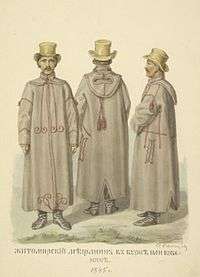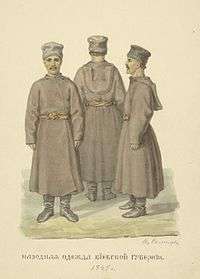Kobeniak

A Zhytomyr burger wearing burka or kobenyak, 1845

Traditional dress of Kiev Governorate, 1845
Kobeniak (Кобеняк) is a Ukrainian traditional male outer garment. A similar terms are Hungarian köpönyeg for "cloak", "mantle", "overcoat", and a historical Polish garment, kopieniak,[1] all terms being derived from the Turkish garment kepenek, which is a shepherd's garment. Kobeniak is also called burka (cf. "Burka (Caucasus)"), kireya, or siryak (бурка, кирея, сіряк).[2]
A kobenyak was the widest garment, so that it could be worn even on top of a kozhukh (fur coat). A distinctive feature is a hood which could cover nearly all the face, with a cut for the eyes and possibly for the mouth, which may be folded back.[2]
References
- ↑ "Encyklopedia staropolska/Kopieniak - Wikiźródła, teksty i materiały źródłowe" (in Polish). Pl.wikisource.org. 2014-02-06. Retrieved 2014-02-17.
- 1 2 Вовк, Хведір. "Студії з української етнографії та антропології", Прага : Укр. громад. вид. фонд, [1916?] (Publ. «Легіографія»). — 354pp.
This article is issued from Wikipedia - version of the 11/28/2014. The text is available under the Creative Commons Attribution/Share Alike but additional terms may apply for the media files.